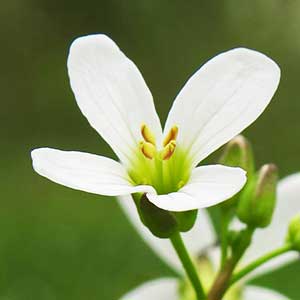Cardamine macrocarpa
Cardamine penduliflora
largeseed bittercress
wetlands bitter-cress, Willamette Valley bitter-cress
absent.
(tuberiform, fragile), 4–9(–11) mm diam., (fleshy).
(simple or several from base), erect or decumbent, (flexuous or straight, narrowly winged-angled), unbranched or branched distally, (1.4–)2–4.5(–5.3) dm.
erect or decumbent at base, unbranched, 2–6(–7.5) dm.
(soon withered), not rosulate.
5–13-foliolate, (4–)10–18(–25) cm, leaflets petiolulate or subsessile;
petiole (3–)5–12(–17) cm;
lateral leaflets subsessile, blade similar to terminal, sometimes smaller;
terminal leaflet (petiolule 0.4–0.7 cm), blade oblong to elliptic or ovate, (0.4–)0.7–1.7(–2) cm, base cuneate or obtuse, margins entire or obscurely 3-lobed.
3–9, middle ones 5–9-foliolate, petiolate, leaflets petiolulate or subsessile;
petiole 1–3 cm, base not auriculate;
lateral leaflets similar to terminal, blade often smaller, with oblique base, distal leaflets subsessile, blade smaller and narrower distally;
terminal leaflet (petiolule 0.2–0.8 cm), blade usually broadly ovate to narrowly lanceolate, rarely oblong, 0.7–2 cm × 2–10 mm, base cuneate to rounded, margins repand, crenate, or 3-lobed.
2–6, 5–11-foliolate, petiolate, leaflets petiolulate or sessile;
petiole 3–10 cm, base not auriculate;
lateral leaflets sessile, blade similar to terminal, smaller;
terminal leaflet (petiolule 0.5–1.5 cm), blade narrowly ovate or oblong to oblanceolate, 1.5–3.5 cm × 2–15 mm, margins entire or toothed to 3-lobed.
ebracteate, (rachis slightly to strongly flexuous or geniculate).
ebracteate.
sepals oblong, 2–3.5 × 0.7–1.2 mm, lateral pair not saccate basally;
petals white, linear, 6–8 × 0.7–1 mm;
filaments: median pairs 4–5 mm, lateral pair 3.5–4 mm;
anthers oblong, 0.7–1 mm.
sepals oblong to ovate, 3.5–5 × 1.8–2.5 mm, lateral pair saccate basally;
petals white, obovate, 12–16 × 6–8 mm, (not clawed, apex rounded or subemarginate);
filaments: median pairs 6–7 mm, lateral pair 4–5 mm;
anthers oblong, 1.5–1.8 mm.
horizontal to divaricate or ascending, (3–)4–9(–12) mm.
ascending to divaricate, (10–)20–40(–60) mm.
linear, (2.5–)3–4.6 cm × 1.7–2.1 mm;
ovules 14–22 per ovary;
style 1–3 mm.
linear, 2.5–4.5 cm × 1.4–2 mm;
ovules 12–24 per ovary;
style 4–6 mm.
dark brown, oblong, 2–2.5 × 0.9–1.2 mm.
brown, oblong, 1.8–2 × 1–1.5 mm.
Cardamine macrocarpa
Cardamine penduliflora
Cardamine macrocarpa is known from the Chisos Mountains, Brewster County.
The characters by which var. texana is said to differ from var. macrocarpa are artificially drawn, and the style length, presence or absence of indumentum on the pedicels, and degree of flexuosity of the raceme rachises do not correlate and can vary within a given area. For these reasons, we do not recognize infraspecific taxa in Cardamine macrocarpa.
(Discussion copyrighted by Flora of North America; reprinted with permission.)
Cardamine penduliflora is known from Douglas County north into Benton, Lane, Marion, Polk, and Yamhill counties.
(Discussion copyrighted by Flora of North America; reprinted with permission.)
